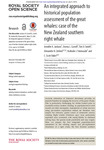An integrated approach to historical population assessment of the great whales
| dc.contributor.author | Jackson, Jennifer A. | en_US |
| dc.contributor.author | Carroll, Emma L. | en_US |
| dc.contributor.author | Smith, Tim D. | en_US |
| dc.date.accessioned | 2016-10-11T05:37:33Z | |
| dc.date.available | 2016-10-11T05:37:33Z | |
| dc.date.issued | 2016 | en_US |
| dc.identifier.other | HPU4160722 | en_US |
| dc.identifier.uri | https://lib.hpu.edu.vn/handle/123456789/23618 | en_US |
| dc.description.abstract | Accurate estimation of historical abundance provides an essential baseline for judging the recovery of the great whales. This is particularly challenging for whales hunted prior to twentieth century modern whaling, as population-level catch records are often incomplete. Assessments of whale recovery using pre-modern exploitation indices are therefore rare, despite the intensive, global nature of nineteenth century whaling. Right whales (Eubalaena spp.) were particularly exploited: slow swimmers with strong fidelity to sheltered calving bays, the species made predictable and easy targets. | en_US |
| dc.format.extent | 16 p. | en_US |
| dc.format.mimetype | application/pdf | en_US |
| dc.language.iso | en | en_US |
| dc.subject | Biology | en_US |
| dc.subject | Ecology | en_US |
| dc.subject | Whaling | en_US |
| dc.subject | Historical abundance | en_US |
| dc.subject | Southern right whale | en_US |
| dc.subject | Bottleneck | en_US |
| dc.title | An integrated approach to historical population assessment of the great whales | en_US |
| dc.type | Article | en_US |
| dc.size | 719KB | en_US |
| dc.department | Education | en_US |
Files in this item
This item appears in the following Collection(s)
-
Education [806]

